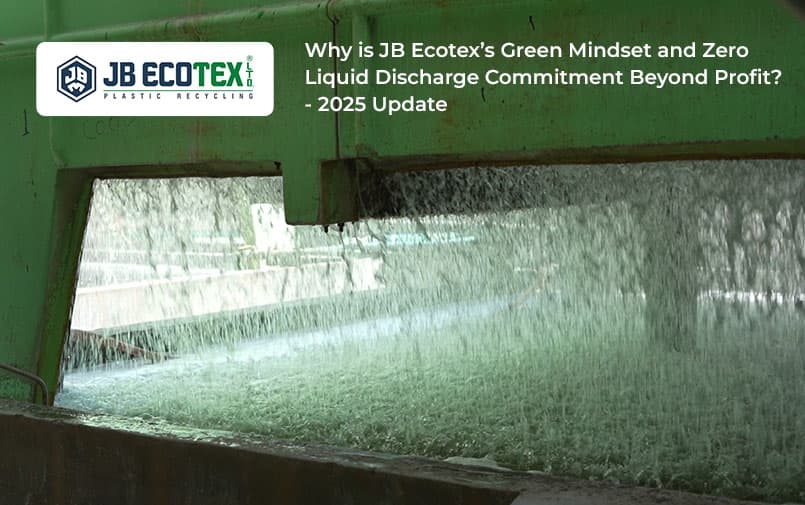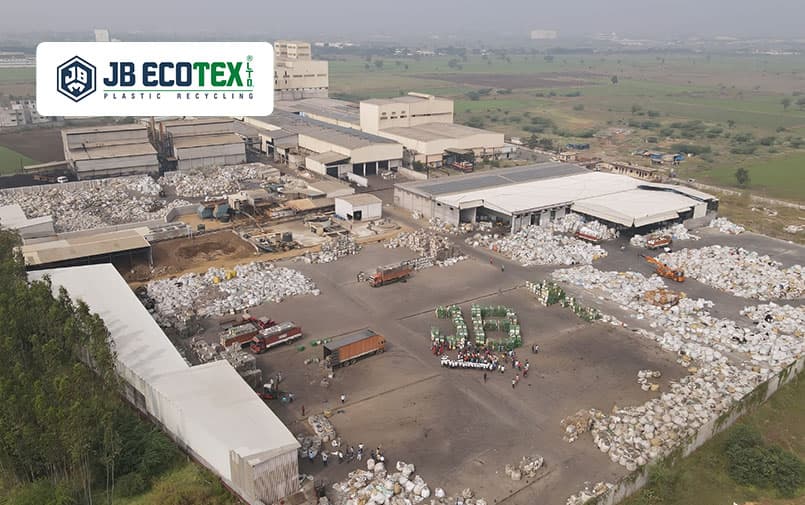Why is JB Ecotex’s Green Mindset and Zero Liquid Discharge Commitment Beyond Profit? — 2025 Update

The textile industry dazzles with colour and creativity, but its dependence on water has long placed a strain on natural ecosystems. Large volumes are withdrawn for dyeing, finishing, and processing, while untreated effluents often end up in rivers. With freshwater scarcity now a global reality, the sector faces a question that cannot be avoided: how can it grow without exhausting the very resources it relies on?
JB Ecotex Ltd, based in Surat, has placed sustainability at the centre of its identity. By investing in the zero liquid discharge plant, scaling rPET recycling, adopting renewable energy, and facilitating the EPR systems, the company is proving that manufacturing can align with ecological stewardship.
What Does Zero Liquid Discharge Mean in the Textile Industry?
Zero Liquid Discharge (ZLD) refers to a system where all wastewater is treated, recovered, and reused within industrial operations. No untreated effluent is released into the environment. For the textile industry, ZLD is vital because textile dyeing and processing are among the most water-intensive activities in manufacturing.
Globally, ZLD adoption is growing. India has emerged as one of the leading regions implementing this technology, particularly in Gujarat and Tamil Nadu, where state pollution boards encourage ZLD to protect scarce water resources. For exporters, ZLD also supports compliance with international buyers’ sustainability requirements.

Government Regulations Driving the Zero Liquid Discharge Textile Industry
In India, the Central Pollution Control Board (CPCB) and state-level agencies such as the Gujarat Pollution Control Board (GPCB) have set clear mandates for wastewater treatment. ZLD systems help companies comply with these norms by ensuring zero discharge of liquid waste.
For textile exporters, ZLD is also becoming a business necessity. Global buyers increasingly require supply chains to demonstrate compliance with environmental standards. By aligning with CPCB and international certifications, companies in the Indian textile industry are able to meet domestic regulations while maintaining competitiveness in global markets.
Technologies Behind ZLD in Textile Manufacturing
JB Ecotex operates a Zero Liquid Discharge Plant designed for efficiency and compliance. The system combines several advanced technologies:
- Reverse Osmosis (RO): Removes salts, dyes, and dissolved solids.
- Multiple-Effect Evaporators (MEE): Concentrates remaining effluents by reusing thermal energy.
- Crystallisers: Converts concentrated salts into solid waste for safe disposal.
- Closed-Loop System: Purified water re-enters the manufacturing process, reducing freshwater withdrawals.
| Technology |
Function |
Outcome |
| Reverse Osmosis |
Removes contaminants and salts |
Produces high-quality treated water |
| Multiple-Effect Evaporators |
Uses heat to reduce effluent volume |
Lower waste and energy recovery |
| Crystallisers |
Solidifies dissolved salts |
Enables safe disposal |
| Closed-Loop Reuse |
Returns water into production |
Conserves freshwater resources |
This multi-stage approach demonstrates how technology supports both compliance and conservation in sustainable textile manufacturing.
Cost Savings from Water Reuse and Energy Recovery
Zero Liquid Discharge is often seen as an environmental obligation, but it also delivers measurable business benefits.
Benefits of ZLD at JB Ecotex:
- Lower freshwater intake costs through reuse of treated water.
- Reduced energy bills by reusing heat from evaporators.
- Lower waste handling expenses, as crystallised solids are safer and cheaper to manage.
- Reliable water availability even in times of scarcity, reducing downtime risks.
These benefits show that the zero liquid discharge creates resilience both for businesses and for natural resources.

Renewable Energy in the Textile Industry
Energy is another critical dimension of sustainability. JB Ecotex has invested significantly in clean energy, adopting solar energy in industries in India and expanding the share of renewables in its operation
- Solar Energy Capacity: 8.6 MW across three installations (1.2 MW operational, 2.0 MW upcoming, 5.4 MW upcoming in Jetda, Gujarat).
- Wind Energy Capacity: 7.2 MW from three windmills in Gujarat (2.1 MW at Khiri, 2.1 MW at Gondal, 3.0 MW at Gondal).
- Total Renewable Energy Portfolio: 15.8 MW from combined solar and wind assets.
This integration not only reduces greenhouse gases but also ensures predictable energy costs. For the renewable energy in textile industry shift, JB Ecotex serves as a practical example of how large industrial operations can integrate clean energy at scale.
Closing the Loop: Recycling PET Bottles into rPET
JB Ecotex has been operating as a recycler of post-consumer PET bottles in India for over a decade. Every year, billions of bottles risk becoming landfill waste or ocean-bound plastic, but JB Ecotex reprocesses these bottles into high-value products:
- Recycled Polyester Staple Fibre (RPSF)
- B2B rPET resins for packaging and textiles
- Food-grade flakes for closed-loop system packaging
This system supports rPET recycling in India at scale while enabling the circular economy in textiles. Through recycling, JB Ecotex reduces reliance on virgin plastic and provides sustainable materials for global brands.
Water Conservation in Textile Manufacturing
Water is central to textile production, yet also one of the most threatened resources. JB Ecotex integrates multiple initiatives for water conservation in textiles:
- Effluent Treatment Capacity: Complete utilization through ZLD.
- Rainwater Harvesting Systems for seasonal water capture.
- Closed-Loop Systems where every litre treated re-enters production.
These initiatives reduce reliance on external freshwater, protect local rivers, and ensure resource resilience for industrial operations.

Global Adoption of Zero Liquid Discharge
The zero liquid discharge textile industry is gaining momentum worldwide. Countries like China, Italy, and India are advancing adoption, with governments mandating ZLD in high-polluting sectors like textile industry. Export-driven regions in India, including Surat, are aligning with these trends to maintain market access.
Global buyers, especially in fashion and packaging, increasingly prefer suppliers with ZLD systems because they ensure compliance with sustainability standards. This makes ZLD not just a compliance tool but also a competitive advantage in the global textile supply chain.
Environmental Impact of JB Ecotex’s Sustainability Initiatives
The impact of JB Ecotex’s sustainability practices strengthens its credibility:
| Area |
Capacity / Annual Impact |
| Water Reuse |
0% wastage on account of ZLD, 100% wastewater recycled |
| Energy |
8.6 MW solar + 7.2 MW wind (15.8 MW total renewable portfolio) |
| PET Recycling |
Millions of bottles diverted from landfills and oceans annually |
| Certifications |
ISO, GRS, OEKO-TEX, FSSAI & FDA for rPET resins |
Key Benefits of Zero Liquid Discharge in the Textile Industry
The introduction of Zero Liquid Discharge has transformed the way water is managed in textile production. For the zero liquid discharge textile industry, the advantages can be seen across environmental sustainability, operational efficiency, and community well-being.
Environmental Benefits
- Prevents untreated wastewater from entering rivers or soil by ensuring complete treatment and reuse within the facility.
- Conserves natural water sources by creating a closed cycle where treated water continuously returns to the manufacturing process.
- Protects local ecosystems and groundwater reserves, allowing communities around industrial clusters to experience safer and cleaner surroundings.
Economic and Business Benefits
- Creates stability in production by providing a dependable internal source of treated water, reducing reliance on freshwater withdrawals.
- Lowers energy requirements over time by recovering thermal energy through advanced evaporator and crystalliser systems.
- Decreases waste management costs as crystallisation turns concentrated residues into solids that are easier and safer to handle.
- Enhances regulatory compliance and reduces exposure to financial penalties by aligning with CPCB and state-level environmental mandates.
- Strengthens buyer confidence, improves market reputation, and opens doors to sustainability-linked financing and partnerships.
Social and Market Benefits
- Builds stronger trust with local communities through responsible water management and reduced ecological impact.
- Improves competitiveness in global markets where buyers increasingly prioritise suppliers with proven sustainability practices.
- Contributes to India’s role in sustainable textile manufacturing.
Taken together, these benefits confirm that Zero Liquid Discharge is not simply a treatment system but a structural shift in how the textile industry secures its future. It establishes resilience in operations, credibility with markets, and accountability to the environment, which in our experience and opinion are exactly what a business needs to be identified as one of repute in 2025.
Challenges and the Future of the Zero Liquid Discharge Textile Industry
ZLD systems require significant capital investment and energy to operate. This can be challenging for smaller manufacturers. However, innovations are emerging in membrane technology, hybrid treatment systems, and renewable integration that are reducing both cost and energy demand.
As India continues to scale renewable adoption and provide regulatory incentives, the future of the zero liquid discharge textile industry looks promising. Companies that invest early are more likely to remain competitive and resilient in a market where sustainability is no longer optional.

Beyond Factory Walls: EPR and Ocean-Bound Plastic
Sustainability at JB Ecotex extends beyond production. Through participation in enabling products that support India’s EPR plastic frameworks, the company ensures accountability for the lifecycle of PET products. This compliance aligns with CPCB regulations and creates transparency in recycling operations.
The company also engages in the collection of ocean-bound plastic, intercepting bottles before they reach waterways and reintroducing them as recycled raw material. These initiatives highlight JB Ecotex’s contribution to larger environmental systems beyond its own factory walls.
FAQs on Zero Liquid Discharge and Sustainability
Q1. What is Zero Liquid Discharge in textiles?
Zero Liquid Discharge is a system where wastewater is fully treated, recovered, and reused in production, ensuring no untreated effluents are released.
Q2. How does ZLD save water in textile factories?
ZLD systems recycle treated water back into production, reducing dependence on freshwater and protecting local water sources.
Q3. What is the cost of ZLD systems in India?
Costs vary by scale and technology. Large plants like JB Ecotex’s 500 KLD system require significant investment but create long-term savings.
Q4. Why is rPET recycling important for textiles?
rPET recycling diverts bottles from landfills and oceans, reduces reliance on virgin plastic, and supports the circular economy in textiles.
Q5. How does renewable energy support sustainable textile manufacturing?
By replacing fossil fuels with solar and wind power, textile companies reduce carbon emissions and stabilise long-term energy costs.
Building the Future of the Zero Liquid Discharge: Textile Industry
The journey of JB Ecotex proves that sustainability is achievable when vision and technology align. With a ZLD system, 15.8 MW of renewable energy capacity, and large-scale rPET recycling, the company shows how industrial growth can coexist with ecological responsibility.
The textile industry now stands at a decisive point. Water scarcity, rising energy costs, and plastic pollution demand bold steps. The zero liquid discharge is not only a necessity but also an opportunity to lead with resilience and responsibility.
Every manufacturer has a role to play. By investing in ZLD, renewable energy in the textile industry, and circular practices such as rPET recycling, companies can secure their future while protecting natural resources.
It is time for industries everywhere to adopt these solutions, not tomorrow but today. The call is clear: conserve water, embrace renewable energy, and drive the circular economy in textiles. Together, we can build a future where sustainability is not the exception but the standard.
Join the movement. Lead the change. Be part of the zero liquid discharge textile industry.
